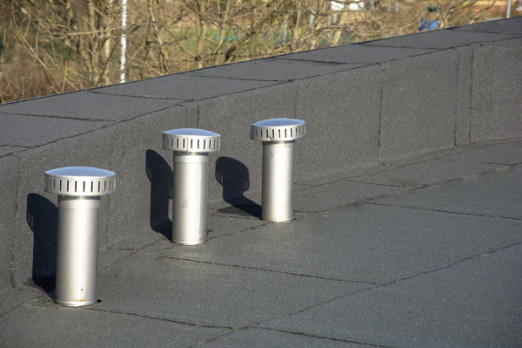This photograph was taken on a flat roof which we visited six months after installation. It shows an electricity cable has been passed through a new hole drilled in the roof. Ian Dryden, specification manager at SIG Design & Technology, discusses putting a cable through a flat roof and how not to invalidate the warranty.
SIG Design & Technology often do annual surveys of school roofs as part of our planned maintenance service, and the cable was spotted during a check on one of these visits. Behind the electricity cable you can see a SVP (Soil Vent Pipe) which has been correctly installed – the cable at the front has not, and therefore has invalidated this roof’s 25-year warranty.
Why do people put cables up on flat roofs?
There are several reasons why people may need to put cables up on a school roof. A common reason is to supply air conditioning units – it makes sense to put them on the roof out of the way, but of course they need to be properly installed.
Equally common are television aerials. In a school environment, it may not be possible to take the aerial through the wall or window frame and up onto the roof, the only way might be through the roof itself. It is also increasingly common for schools to have CCTV and security lighting installed, and once again, getting the cameras up on the roof out of the way is a good idea.
However, in each of these situations it is absolutely essential that if it needs to make a hole in the membrane, it is done in a way that does not invalidate the warranty, otherwise if the roof fails anywhere, the warranty won’t cover them.
Why does putting a cable through the roof invalidate the warranty?
To guarantee a flat roof, which may cover failure for 20 or more years, the manufacturer of the roofing system needs to be sure that the roof has been designed and installed correctly; otherwise there would be a likelihood that they would go out of business due to excessive claims.
For this reason, manufacturers produce standard details for upstands, penetrations (holes through the roof), parapets and abutments (roofing up to a wall). These details are proven to work in the weather conditions expected for the roof concerned, and their installation is inspected by our team to ensure it is done correctly. If it is necessary to produce a special change in the way a roof is installed, this process, with the necessary drawn details, needs to be approved by the manufacturer and installed according to their instructions. The manufacturer needs to be assured that the entire roof has been correctly installed, before it will issue its warranty certificate.
In the case of this cable, a standard detail was not used. A contractor came along and drilled a hole where it was convenient. The cable has been surrounded with a small piece of felt, and a lot of silicone sealant has been used in the hope of keeping the moisture out. Unfortunately, there is no way of knowing how the seal will perform in different weather conditions, with the cable moving about, and whether the materials used are compatible with the roofing fabric
It is also worth mentioning that the bitumen roofing felt used may have been heated up with a flame torch. Not only does this constitute a fire hazard, but it also likely that the process did not comply with the NFRC Safe2Torch guidance, which has been developed by the National Federation of Roofing Contractors to prevent unnecessary fires on roofs.
In another case there is an example of a non-standard flat roof penetration for a whole bunch of cables. Again, there was a fire risk when this was installed – the plastic piping would have been dangerously close to a source of flame, and because it is a non-standard detail, this would also invalidate the warranty, because there is no guarantee that the waterproofing here won’t leak either.
How do we put a cable through the flat roof?
So, what is the correct way to include a penetration for an electricity cable in a flat roof? Here is an example.
The correct thing to do would be to use a Signature Cable Penetration Unit. It looks very boring, but it works. The unit consists of an upstand kerb (similar to the upstand you will see around roof lights) and a cowling.
The upstand kerb fits around the hole and provides the correct amount of upstand (150mm) against which the flashing is fixed, and the cowling keeps the rain off, allowing the cable to move relatively freely without coming into contact with the membrane.
Because it is installed by an accredited contractor in a standard way it doesn’t interfere with the performance of the roof and therefore won’t invalidate the warrantee.
Retrofit Wrongly Installed Cables!
One useful characteristic of the SIGnature Cable Penetration Unit is that the upstand has a gate in it, which means that it can be installed retrospectively over a wrongly installed cable.
So even if a contractor has made a hole in the roof, if we come across a cable that has been incorrectly installed, the warranty can normally be restored by having a SIGnature Cable Penetration Unit installed by a suitably accredited installer.

